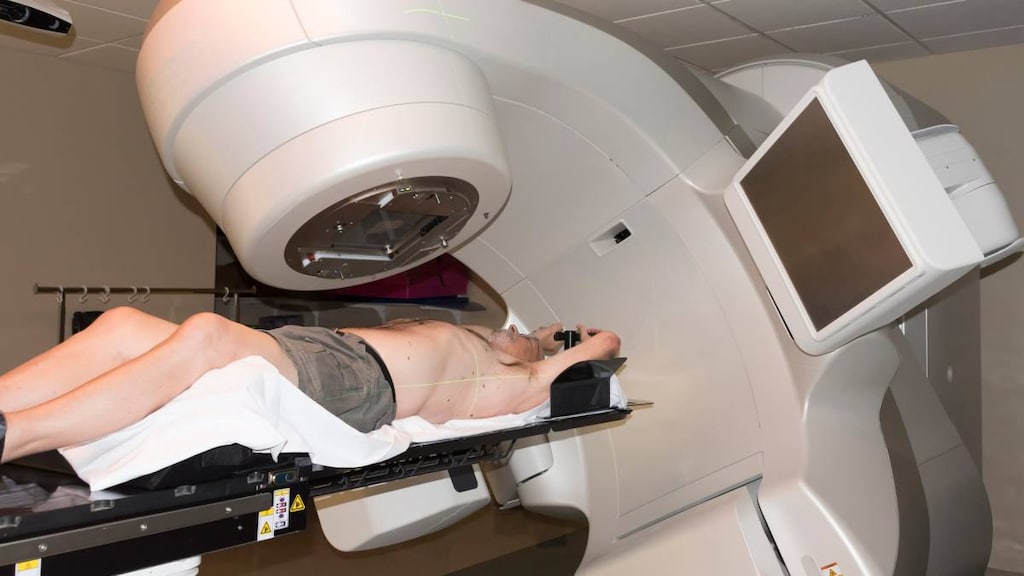Dosage Forms
Excipient information presented when available (limited, particularly for generics); consult specific product labeling.
Tablet, Oral:
Nubeqa: 300 mg
Pharmacology
Mechanism of Action
Darolutamide is a competitive androgen receptor inhibitor. In addition to androgen binding inhibition, darolutamide also inhibits androgen receptor translocation and androgen receptor-mediated transcription. Keto-darolutamide (active metabolite) has similar in vitro activity to darolutamide. Androgen receptor inhibition results in decreased proliferation of prostate tumor cells and increased apoptosis, leading to a decrease in tumor volume.
Pharmacokinetics/Pharmacodynamics
Distribution
119 L; darolutamide has low blood-brain barrier penetration (Fizazi 2019).
Metabolism
Primarily metabolized by CYP3A4, as well as by UGT1A9 and UGT1A1; active metabolite is keto-darolutamide.
Excretion
Urine: 63.4% (~7% as unchanged drug); feces: 32.4% (~30% as unchanged drug); Clearance: 116 mL/minute.
Time to Peak
~4 hours.
Half-Life Elimination
~20 hours (darolutamide and keto-darolutamide).
Protein Binding
Darolutamide: 92%; keto-darolutamide (active metabolite): 99.8%; primarily to serum albumin.
Use in Specific Populations
Special Populations: Renal Function Impairment
Darolutamide exposure was increased by ~2.5-fold in noncancer subjects with severe renal impairment (eGFR 15 to 29 mL/minute/1.73 m2) not receiving dialysis as compared to healthy subjects.
Special Populations: Hepatic Function Impairment
Darolutamide exposure was increased by ~1.9-fold in noncancer subjects with moderate (Child Pugh class B) hepatic impairment as compared to healthy subjects.
Use: Labeled Indications
Prostate cancer, nonmetastatic, castration-resistant: Treatment of nonmetastatic castration-resistant prostate cancer.
Contraindications
There are no contraindications listed in the manufacturer's labeling.
Dosage and Administration
Dosing: Adult
Prostate cancer, nonmetastatic, castration-resistant: Oral: 600 mg twice daily (in combination with a gonadotropin-releasing hormone analog [if had not received bilateral orchiectomy]); continue until disease progression or unacceptable toxicity (Fizazi 2019).
Missed dose: If a dose is missed, administer as soon as possible prior to the next scheduled dose; do not take 2 doses at the same time to make up for a missed dose.
Dosing: Geriatric
Refer to adult dosing.
Dosing: Adjustment for Toxicity
Grade 3 or higher toxicity (or intolerable adverse reaction): Withhold darolutamide or reduce dose to 300 mg twice daily until symptoms improve; may then resume therapy at 600 mg twice daily. Dose reduction <300 mg twice daily is not recommended.
Administration
Oral: Administer with food. Swallow tablets whole.
Storage
Store at 20°C to 25°C (68°F to 77°F); excursions permitted between 15°C and 30°C (59°F and 86°F). Keep the bottle tightly closed after initial opening.
Drug Interactions
Alpelisib: BCRP/ABCG2 Inhibitors may increase the serum concentration of Alpelisib. Management: Avoid coadministration of BCRP/ABCG2 inhibitors and alpelisib due to the potential for increased alpelisib concentrations and toxicities. If coadministration cannot be avoided, closely monitor for increased alpelisib adverse reactions. Consider therapy modification
Asunaprevir: OATP1B1/1B3 (SLCO1B1/1B3) Inhibitors may increase the serum concentration of Asunaprevir. Avoid combination
Cladribine: BCRP/ABCG2 Inhibitors may increase the serum concentration of Cladribine. Management: Avoid concomitant use of BCRP inhibitors during the 4 to 5 day oral cladribine treatment cycles whenever possible. If combined, consider dose reduction of the BCRP inhibitor and separation in the timing of administration. Consider therapy modification
CloZAPine: CYP3A4 Inducers (Weak) may decrease the serum concentration of CloZAPine. Monitor therapy
Elagolix: OATP1B1/1B3 (SLCO1B1/1B3) Inhibitors may increase the serum concentration of Elagolix. Avoid combination
Grazoprevir: OATP1B1/1B3 (SLCO1B1/1B3) Inhibitors may increase the serum concentration of Grazoprevir. Avoid combination
Inducers of CYP3A4 (Moderate) and P-glycoprotein: May decrease the serum concentration of Darolutamide. Avoid combination
Inducers of CYP3A4 (Strong) and P-glycoprotein: May decrease the serum concentration of Darolutamide. Avoid combination
Inhibitors of CYP3A4 (Strong) and P-glycoprotein: May increase the serum concentration of Darolutamide. Monitor therapy
NiMODipine: CYP3A4 Inducers (Weak) may decrease the serum concentration of NiMODipine. Monitor therapy
PAZOPanib: BCRP/ABCG2 Inhibitors may increase the serum concentration of PAZOPanib. Avoid combination
Revefenacin: OATP1B1/1B3 (SLCO1B1/1B3) Inhibitors may increase serum concentrations of the active metabolite(s) of Revefenacin. Avoid combination
Rosuvastatin: Darolutamide may increase the serum concentration of Rosuvastatin. Management: Avoid coadministration of darolutamide and rosuvastatin if possible. If combined, monitor for increased rosuvastatin effects/toxicities and consider a rosuvastatin dose reduction. Consider therapy modification
Talazoparib: BCRP/ABCG2 Inhibitors may increase the serum concentration of Talazoparib. Monitor therapy
Topotecan: BCRP/ABCG2 Inhibitors may increase the serum concentration of Topotecan. Avoid combination
Ubrogepant: CYP3A4 Inducers (Weak) may decrease the serum concentration of Ubrogepant. Management: Use an initial ubrogepant dose of 100 mg and second dose (if needed) of 100 mg when used with a weak CYP3A4 inducer. Consider therapy modification
Ubrogepant: BCRP/ABCG2 Inhibitors may increase the serum concentration of Ubrogepant. Management: Use an initial ubrogepant dose of 50 mg and second dose (if needed) of 50 mg when used with a BCRP inhibitor. Consider therapy modification
Voxilaprevir: OATP1B1/1B3 (SLCO1B1/1B3) Inhibitors may increase the serum concentration of Voxilaprevir. Avoid combination
Adverse Reactions
>10%:
Central nervous system: Fatigue (16%)
Hematologic & oncologic: Neutropenia (20%; grade 3/4 4%)
Hepatic: Increased serum aspartate aminotransferase (20%), increased serum bilirubin (16%)
Neuromuscular & skeletal: Asthenia (≤16%)
1% to 10%:
Cardiovascular: Ischemic heart disease (4%), cardiac failure (2%)
Dermatologic: Skin rash (3%)
Neuromuscular & skeletal: Limb pain (6%)
Frequency not defined:
Cardiovascular: Hypertension
Genitourinary: Hematuria, urinary retention
Respiratory: Pneumonia
Warnings/Precautions
Concerns related to adverse effects:
- Bone marrow suppression: Neutropenia was observed more frequently with darolutamide than placebo in a clinical trial, although the incidence was not high.
Disease-related concerns:
- Cardiovascular disease: Androgen-deprivation therapy may increase the risk for cardiovascular disease (Levine 2010).
- Hepatic impairment: Patients with moderate hepatic impairment (Child-Pugh class B) have increased darolutamide exposure; dose reduction is recommended.
- Renal impairment: Patients with severe renal impairment (eGFR 15 to 29 mL/minute/1.73 m2) who are not receiving hemodialysis have increased darolutamide exposure; dose reduction is recommended.
Concurrent drug therapy issues:
- Drug-drug interactions: Potentially significant interactions may exist, requiring dose or frequency adjustment, additional monitoring, and/or selection of alternative therapy. Consult drug interactions database for more detailed information.
Monitoring Parameters
Monitor hepatic and renal function as clinically necessary. Monitor adherence.
Pregnancy
Pregnancy Considerations
Based on the mechanism of action, darolutamide may cause fetal harm and pregnancy loss if utero exposure occurs.
Males with female partners of reproductive potential should use effective contraception during darolutamide treatment and for 1 week after the last darolutamide dose.
Patient Education
What is this drug used for?
- It is used to treat prostate cancer.
Frequently reported side effects of this drug
- Loss of strength and energy
- Pain in arms or legs
Other side effects of this drug: Talk with your doctor right away if you have any of these signs of:
- Infection
- Signs of a significant reaction like wheezing; chest tightness; fever; itching; bad cough; blue skin color; seizures; or swelling of face, lips, tongue, or throat.
Note: This is not a comprehensive list of all side effects. Talk to your doctor if you have questions.
Consumer Information Use and Disclaimer: This information should not be used to decide whether or not to take this medicine or any other medicine. Only the healthcare provider has the knowledge and training to decide which medicines are right for a specific patient. This information does not endorse any medicine as safe, effective, or approved for treating any patient or health condition. This is only a brief summary of general information about this medicine. It does NOT include all information about the possible uses, directions, warnings, precautions, interactions, adverse effects, or risks that may apply to this medicine. This information is not specific medical advice and does not replace information you receive from the healthcare provider. You must talk with the healthcare provider for complete information about the risks and benefits of using this medicine.




